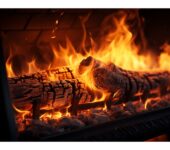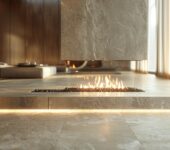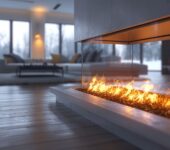Table of Contents
Having a fireplace in your home or business isn’t just a way to enhance your architectural design – it can actually be good for your physical and mental health.
If you’re thinking about integrating a new fireplace into your property, you’ll first need to decide which of the many types of fireplaces you’ll want to be installed. There are benefits to these different varieties, and it’s important to understand the distinctions.
For example, what is the difference between linear fireplaces and traditional ones? Which is the best choice for your home? Read on and we’ll walk you through the details.
Defining the Traditional Fireplace
Let’s start with the most basic conception of the fireplace.
Traditional fireplaces are the classic, cozy fireplaces that many of us think of when we imagine a warm, inviting home.
These fireplaces feature a deep, open firebox and are typically fueled by wood. They are often the centerpiece of a living room or family room. The traditional fireplace will usually add a more rustic (or, yes, traditional) touch to any home.
One of the primary advantages of traditional fireplaces is their authenticity.
There is nothing quite like the sound and smell of a wood-burning fire, and traditional fireplaces provide that experience. Plus, they use wood as a fuel source. This means they can be less expensive to operate than a gas or electric fireplace, especially if you have a source of firewood on your property.
However, traditional fireplaces do have some downsides.
They can be messy and require regular cleaning to remove ash and soot. Also, because they produce smoke and particulate matter, they can be a slight health hazard if not properly vented. Depending on your space and what it’s like, a traditional fireplace might also not be the right fit.
This kind of fireplace requires a significant amount of space and may not be practical for smaller rooms or apartments.
What are Linear Fireplaces?
Linear fireplaces are a relatively new type of fireplace that has become increasingly popular in recent years.
These fireplaces feature a long, rectangular design and a relatively shallow depth, often measuring only a few inches deep. They can be installed in a variety of locations, including on a wall or in a corner. In most cases, they will be fueled by gas or electricity.
One of the primary advantages of linear fireplaces is their modern, sleek design.
They can add a contemporary touch to any room. For this reason, they are often used in modern or minimalist homes. Additionally, because they are relatively shallow, they don’t require as much space as a traditional fireplace.
This makes them ideal for smaller rooms or apartments that might not be a good fit for a more traditional fireplace.
Another advantage of linear fireplaces is that they are generally more efficient than traditional fireplaces. Because they use gas or electricity as a fuel source, they don’t produce the same amount of smoke. They also don’t create as much particulate matter as a wood-burning fireplace would.
What does this mean for you? They are much easier to maintain and don’t require as much cleaning.
These are among the most popular benefits of linear fireplaces, but there are many reasons to consider this type of fireplace for your property.
Choosing Between a Linear and Traditional Fireplace
When deciding between a linear fireplace and a traditional fireplace, there are a few factors to consider. Many of them we’ve briefly touched on above, but it can be helpful to consider them in contrast to one another.
There are a few thought exercises to go through when deciding which fireplace type will be the best fit for your home.
Style and Aesthetic
First, think about the style of your home and which type of fireplace would best complement it.
If you have a modern or minimalist home, a linear fireplace might be the best fit. If you have a more traditional or rustic home, a traditional fireplace might be the way to go.
You could always play this sort of contrast to your advantage, but for the most, matching your fireplace to your existing home atmosphere will be your best bet.
Size and Layout
Another important factor to consider is the size and layout of the room where the fireplace will be installed.
If you have limited space, a linear fireplace may be the better choice since it doesn’t require as much room. However, if you have a large room with high ceilings, a traditional fireplace may be more appropriate.
In this kind of space, the traditional style can be used to create a cozy and inviting atmosphere.
Lifestyle and Enjoyment
Lastly, think about your lifestyle and how you plan to use the fireplace. This is a subject we haven’t touched on at all.
If you want the convenience of a low-maintenance fireplace that you can easily turn on and off, a linear fireplace can provide that.
However, if you enjoy the process of building and maintaining a fire, and the ambiance that a traditional fireplace provides, a traditional fireplace might be the better choice for you.
Ultimately, the decision between a linear fireplace and a traditional fireplace will depend on your personal preferences and the specific needs of your home.
Investing in a New Fireplace
If you’re looking to bring a special touch to your home or business, installing a new fireplace can be a great idea. Before you make your plans, however, you’ll need to understand which type of fireplace will best fit your space.
The above information can help you to understand what linear fireplaces provide and how they differ from the more traditional variety of fireplaces. With this knowledge, you can make the right decision for your property.
Have more questions about fireplace installation? Looking to get started soon? Give us a call anytime for more assistance.
Latest Articles

Is It Normal For Sparks To Come Out Of Chimney?
Table of Contents1 What Are Sparks in a Chimney?2 What Are the Dangers of Sparks in a Chimney?3 How to Prevent Sparks from Coming Out

How Garage Doors Work
Table of Contents1 Types of Garage Doors2 Components of a Garage Door3 How a Garage Door Works4 Safety Features of Garage Doors5 Maintenance and Troubleshooting

What Kind Of Paint To Use On Metal Garage Doors
Table of Contents1 Why Paint Your Metal Garage Doors?2 Types of Paint for Metal Garage Doors3 Factors to Consider When Choosing Paint for Metal Garage



















































































